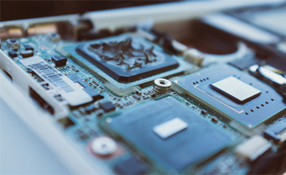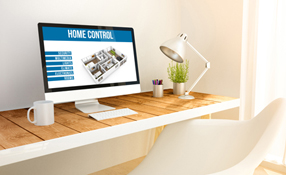 |
| Cloud connectivity can provide a linkage between the mobile users and the facilities and systems they want to interact with |
From enterprise applications to small businesses, schools, health care facilities and beyond, investments in physical security systems provide valuable resources to help protect people, property and assets – and ultimately the financial security and well-being of the organization. As need and demand for better security has dramatically increased over the years, today’s technology is more software and computer driven, enabling systems to be networked internally or managed externally through cloud computing platforms.
Increased Connectivity
In today’s mobile, connected world, end users expect the ability to view and manage their systems from anywhere at any time, making hosted access control an attractive and economical proposition. Cloud connectivity can provide a linkage between the mobile users and the facilities and systems they want to interact with, whether those systems are in one place or distributed over several locations. And, cloud services can deliver scalable capabilities quickly – often on demand – without the need to purchase, install, or configure any new on-site physical assets, such as servers or work stations.
However, these benefits are not without their drawbacks and potential risks, most notably cybersecurity and the availability of the system and its data. Any system outage, whether the result of a network breach, server failure or other factor, compromises security and could leave an organization vulnerable. The resulting risks could be catastrophic, making it vital that organizations ensure that their access control, video surveillance and other security systems are always up and running. Management concerns over the cybersecurity risks of cloud-based solutions grow with each high-profile data breach that is reported, and with good reason.
 |
| Risks could be catastrophic, making it vital that organizations ensure that their security systems are always up and running |
Maintaining Critical Functions
As companies move forward with IT and physical security planning, here are some factors to consider and incorporate appropriately into the process.
Step 1: Consider the benefits and risks of cloud-based services objectively
Be honest about how your company functions today, how you want it to function in the future, and how cloud-based services might help get you from here to there. But don’t think that cloud services will solve problems magically – when it comes down to it, cloud services are really just renting hardware and software in somebody else’s facility. There are definitely benefits to renting versus owning, but there are also significant risks. And, incorporating the cloud services into your operation, and/or maintaining them, will continue to take time and resources that will need to be included in your plans.
Step 2: Determine which functions must continue, even in the event of cloud system failure.
This should be an extension of your current business strategy, which already evaluated your essential functions, personnel, etc. Remember that the risks are compounded if the cloud is used to store or process important business data – in the event of a failure, that data may not be accessible or under your control. Be very clear about the procedures and steps you will take if your cloud services go down so you can keep your operations up and running.
Step 3: Implement backup processes to ensure critical business continuity.
Once the intended benefits of cloud services are evaluated in the light of foreseeable risks and critical functions are clearly identified, it is time to put the changes into effect, along with backup and contingency plans that will be triggered in the event of service disruptions. For access control, it is essential to quickly be able to re-load your list of authorized users and permissions so that normal operations can resume as soon as possible after an outage or failure.
 |
| Data backup and contingency plans are crucial in the event of service disruptions |
Security Applications Of Cloud-Based Services
Most firms are realising that physical security systems, including access control and video surveillance, are critical facility functions that need to be maintained 24/7 under any circumstances. Even so, both of these security applications are current offerings from cloud-based service providers that companies can consider to supplement or outsource their internal functions.
Choosing An Approach
As an example, let’s see how the suggestions in the steps above might affect a firm’s planning for access control. Before we start, we should note that different organizations will have varying risk tolerances which will contribute to what type of access control solution they choose, on premise or cloud. There is no single “right” or “wrong” answer for the general question of how to choose the right approach or services; the right answer depends on the specifics of the situation for each firm.
1. Considering Cloud Service Benefits
We would consider the potential benefits of a cloud service for access control, sometimes called ACaaS, for Access Control as a Service. Offerings vary, but might include the provision of a server and software to process access requests, which would interact with the local access controllers via IP connectivity. Thus, it would generally be required for the controllers to support not only IP communications, but also encryption and digital certifications. Older controllers would have to be upgraded if they could not support these functions. Managed access control is a service where the firm pays a third party to administer the access control platform, including such tasks as adding and deleting access rights, printing badges and other credentials, monitoring for doors that are propped open or forced open.
On the upside, up-front capital costs could be reduced by limiting the amount of purchased hardware, and the ongoing management and maintenance of that hardware is done by the supplier. Depending on the supplier, the ongoing service costs might be based on the number of controlled doors, the number of users or credentials, the number of transactions, or some combination thereof.
On the downside, the list of credentialed users will now reside at the supplier’s location, where it could be subject to tampering, loss and/or theft. And, if the host server must be contacted in order to process a transaction (that is, open a door), then the operation of the system now depends on active and successful communication with the supplier’s off-site server at all times. A complete tradeoff can now be evaluated that compares the cost of owning hardware and software, along with necessary maintenance, and expected usage patterns, to the proposed cost from the cloud supplier and various related contract terms.
2. Potential Risks
It goes without saying that in the event of a cloud-based or premises based access control failure, people within your facility will still need to be able to exit without the risk of being trapped inside. The question is, how important will it be for people to be granted or denied access based upon the configuration in the database prior to the failure? And, how urgent is adding/deleting authorized users, permissions and the other functions that require access to the host access control software? How much impact would there be on the company if the list of authorized users was altered or stolen by hackers?
3. Contingency Plan
An implementation and backup plan is developed and put into action. For the purpose of this example, let’s assume that ACaaS was approved and put into place. One part of the plan might be to capture complete back-ups of the user database periodically and to store them both on-site and off-site. Another part of the solution might be to select access controllers that have the ability to be battery backed up and hold a copy of the user database and device configuration locally so they can continue to function even in the event of a communication breakdown with the cloud supplier’s server or power outage. By taking this approach, the affected facility would be able to continue operating normally in the event of a communication breakdown or power outage, and update authorized changes after network communications were restored.
Implementing The Best Cloud-Based Plan
Both hardware and software technical advancements continue to provide new options for security management across every vertical market application. When changes are being considered that affect organizational physical and IT security, it is important to evaluate the options carefully.
Choosing an equipment supplier that has designed their products for maximum uptime is critical. This criteria will enable more effective and cost-efficient contingency planning, so you can implement the best plans possible for all your operations.























